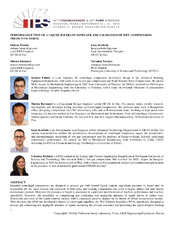| dc.contributor.other | Turbomachinery Symposium (45th : 2016) | |
| dc.creator | Falomi, Stefano | |
| dc.creator | Scarbolo, Luca | |
| dc.creator | Bertoneri, Matteo | |
| dc.creator | Ferrara, Veronica | |
| dc.date.accessioned | 2017-03-14T21:29:11Z | |
| dc.date.available | 2017-03-14T21:29:11Z | |
| dc.date.issued | 2016 | |
| dc.identifier.uri | https://hdl.handle.net/1969.1/159788 | |
| dc.description | Lecture | en |
| dc.description.abstract | Standard centrifugal compressors are designed to process gas with limited liquid content: significant presence of liquid may be responsible for the rapid erosion and corrosion of both static and rotating components that yield to higher failure risk and shorter maintenance periods. Moreover the presence of liquid is associated to significant modifications of machine performance and machine operability. However, the possibility of compressing gas containing non negligible amounts of liquid allows to reduce size, dimensions and costs of the liquid removal stations with a consequent positive impact on the layout of subsea compression stations. With this aim, the OEM has developed a family of centrifugal impellers, the Wet Tolerant Impellers (WTI), specifically designed to process gas containing non negligible amounts of liquid, increasing the erosion resistance and promoting the liquid droplets breakup for subsequent stages.
The validation of WTI has been carried out at the Norwegian University of Science and Technology (NTNU) in Trondheim; the test rig is a single stage air-water multiphase open-loop facility driven by a 450 kW motor capable of a maximum continuous speed equal to 11000 rpm.
In the test campaign, first a standard impeller has been tested to assess the impact of liquid phase on performance and operating range (results have been summarized in Ferrara et al. [14]), then the specific WTI design has been tested and directly compared with the standard impeller results. The comparative test campaign has been focused on three different aspects: Performance evaluation in dry and wet conditions; Operating range evaluation in dry and wet conditions; Comparative erosion test.
WTI test results have been compared with the performance curves obtained through the OEM internal tool specifically developed for the prediction of centrifugal compressors performance in wet conditions. Performance has been assessed varying the amount of liquid carried by the gas at two different rotating speeds: five Liquid Mass Fractions (LMF) have been considered for each speedline and a minimum of six test points have been recorded from partflow to overflow. The effect of liquid on machine operability has been assessed through a left-limit investigation by means of dynamic pressure probes readings in order to evaluate the stall/surge behavior for different values of LMF. In addition, the function between head rise to surge and LMF has been reconstructed.
Tests results have shown the effectiveness of liquid tolerant design: erosion effects are weaker on WTI while performance levels and operating range are comparable to those of standard impellers. | en |
| dc.format.medium | Electronic | en |
| dc.format.mimetype | application/pdf | |
| dc.language.iso | en | |
| dc.publisher | Turbomachinery Laboratories, Texas A&M Engineering Experiment Station | |
| dc.relation.ispartof | Proceedings of the 45th Turbomachinery Symposium | en |
| dc.subject.lcsh | Turbomachines | en |
| dc.title | Performance Test Of A Liquid Tolerant Impeller And Validation Of Wet Compression Predictive Model | en |
| dc.type.genre | Presentation | en |
| dc.type.material | Text | en |
| dc.format.digitalOrigin | born digital | en |
| dc.identifier.doi | https://doi.org/10.21423/R1J01M | |


